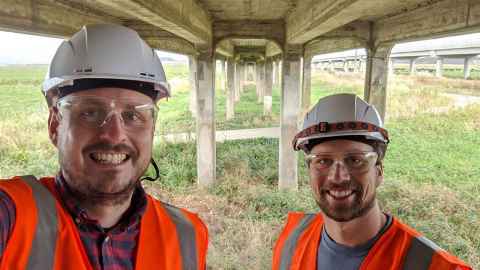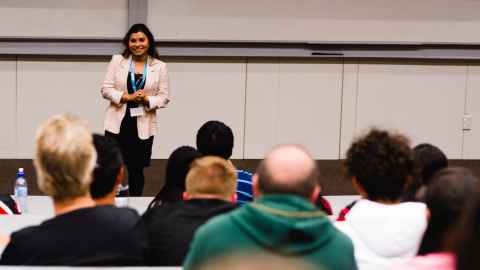Focus on New Zealand’s built environment key for future engineers
29 October 2020
Our built environment poses a number of challenges for the next generation of engineers. Dr Lucas Hogan and Dr Subeh Chowdhury talked through some of the issues unique to New Zealand and how engineers are solving them.

Dr Hogan’s expertise lies in Structural Engineering, where he brings his enthusiasm for “scientifically breaking stuff” in the Structural Testing Laboratory at our Newmarket Campus. He’s also responsible for teaching Part II Civil Engineering students and ensuring they understand the principles of the discipline and share his excitement for how people can build a better environment for each other.
He makes the point that many of the challenges facing our built environment come from the fact that most of the infrastructure we engage with is often decades old. Dr Hogan raises the example of current flood protection works on Auckland’s Tamaki Drive as an infrastructure challenge where engineers need to consider a range of questions, including how this project may impact people’s lives.
“So they're going to raise the road in these couple of little stretches by probably three to four hundred millimetres,” he explains. “That doesn’t seem like much but there are thousands of cars driving on that road every day. How do you do that work while maintaining those transportation routes? Then how do you adjust and plan the future use of that piece of road so that it's better suited for what we suspect the future users are going to be like?”

According to Dr Chowdhury, future users of Auckland’s roads are increasingly more likely to be public transport users for a range of different reasons. In particular, she highlights people’s growing awareness of the environment and the rising cost of petrol as catalysts for more people using public transport, all of which will affect the ways future engineers will have an impact.
“Engineers need to be more aware about the impact of their decisions on different population groups. For example, catering to the needs of commuters can impact those who are not commuters, or don’t do a 8-5 work trip,” Dr Chowdhury explained. “Solving these problems will require graduates who have a passion to meet needs of different communities and can show leadership skills."
Dr Hogan also had some thoughts about the types of attributes students need to be successful civil engineers who can have a positive impact on our built environment. Aside from the technical foundations students will learn as they study, he feels a successful engineer is curious and empathetic, as those traits will stop them from getting tunnel vision and never thinking outside their specific speciality in an industry that’s extremely collaborative.
“To build a building, well, there's planning, there's a geotechnical engineer, there's a structural engineer, there's an architect. There's mechanical, electrical and plumbing and then the facade people. There's all of these groups and then there's the contractors actually building the thing,” Lucas began.
“Plus, there's the owner and there's the tenants and the neighbours. So you need to have curiosity. And that’s going to help you understand and be empathetic towards other perspectives and learn how to work towards what's going to be the best solution, instead of just having a dogmatic view of ‘no, I'm right because I’ve decided that I’m right’.”
Our students learn about how people relate to their built environment and the technical principles that make it possible. This gives them an understanding of how their careers can make a difference towards the communities in which they live and work, and teaches them that being a great engineer can be about so much more than just having strong technical skills.